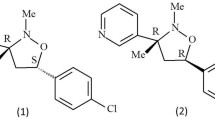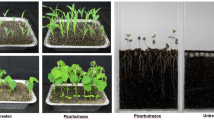Abstract
This study assessed the efficacy of five active ingredients (boscalid, carbendazim, cyprodinil, fluazinam, and fludioxonil) at five concentrations (0.01, 0.10, 1.00, 10.00, and 100.00 mg/L a.i.) against nine Macrophomina isolates (M. phaseolina: CMM1556, CMM4748, and CMM4764; M. pseudophaseolina: CMM2163, CMM4815, and CMM4767; and M. euphorbiicola: CMM2158, CMM4868, and CMM4867). We evaluated daily mycelial growth, growth inhibition percentage, and the effective concentration that inhibits 50% of the radial mycelial growth (EC50). Additionally, the in vivo impact of fluazinam and fludioxonil on the incidence and severity of root rot and vine decline, as well as melon plants biometrics, were determined. Increasing fungicide dose resulted in a higher percentage of mycelial growth inhibition, with the most favorable outcomes observed at 100.00 mg/L a.i. for all tested products. Overall, the Macrophomina isolates exhibited greater tolerance to boscalid (EC50 = 13.40 mg/L a.i.), followed by cyprodinil (EC50 = 1.18 mg/L a.i.), carbendazim (EC50 = 0.05 mg/L a.i.), fluazinam (EC50 = 0.03 mg/L a.i.), and fludioxonil (EC50 = 0.03 mg/L a.i.). The latter two demonstrated high efficacy in vitro. While none of the products achieved complete control of the fungus in vivo, the lowest incidence and severity of root rot and vine decline in melon plants were 28.57% and 0.29, respectively, in plants inoculated with M. euphorbiicola and treated with fludioxonil. For the other species and isolates, fluazinam exhibited better control, resulting in reduced mass loss and root length.




Similar content being viewed by others
Data availability
All data generated or analyzed during this study are included in this published article.
References
AGROFIT (2023) Banco de informações sobre os produtos agroquímicos fitossanitários registrados no Ministério da Agricultura, Pecuária e Abastecimento (MAPA). Available at: http://agrofit.agricultura.gov.br. Accessed on January 19, 2023
Ambrósio MMQ, Dantas ACA, Martínez-Perez E, Medeiros AC, Nunes GHS, Picó MB (2015) Screening a variable germplasm collection of Cucumis melo L. for seedling resistance to Macrophomina phaseolina. Euphytica 206:287–300
Basandrai AK, Pandey AK, Somta P, Basandrai D (2021) Macrophomina phaseolina - host interface: Insights into an emerging dry root rot pathogen of mungbean and urdbean, and its mitigation strategies. Plant Pathology 70:1263–1275
Brito ACQ, Mello JF, Michereff SJ, Souza-Motta CM, Machado AR (2019) First report of Macrophomina pseudophaseolina causing stem dry rot in cassava in Brazil. Journal of Plant Pathology 4:1245–1245
Bruton, BD (1998) Soilborne diseases in cucurbitaceae: Pathogen virulence and host resistance. In: McCreight J (ed). Cucurbitaceae 98.International Society of Horticultural Science, Alexandria, Egypt. 143-166
Cannonball WG (2023) Fungicide: PRODUCT DETAILS. Available at: https://www.syngenta-us.com/fungicides/cannonball-wg. Accessed on April 19, 2023
Cavalcante ALA, Negreiros AMP, Tavares MB, Barreto ES, Armengol J, Sales Júnior R (2020) Characterization of five new Monosporascus species: Adaptation to environmental factors, pathogenicity to cucurbits and sensitivity to fungicides. Journal of Fungi 169:1–14
Cohen R, Omari N, Porat A, Edelstein M (2012) Management of Macrophomina wilt in melons using grafting or fungicide soil application: Pathological, horticultural, and economical aspects. Crop Protection 35:58–63
Cohen R, Elkabetz M, Edelstein M (2016) Variation in the responses of melon and watermelon to Macrophomina phaseolina. Crop Protection 85:46–51
Edgington LV, Khew KL, Barrow GL (1971) Fungitoxic spectrum of benzimidazole compounds. Phytopathology 61:42–44
FAO (Food and Agriculture Organization) (2023) FAOSTAT - Food and agriculture data. Available at: https://data.apps.fao.org/catalog/dataset/crop-production-yield-harvested-area-global-national-annual-faostat/resource/45e995e9-1021-4288-abed-ab933d3a3c01. Accessed on July 01, 2023
Farr DF, Rossman AY (2023) Fungal Databases, U.S. National Fungus Collections, ARS, USDA. Available at: https://nt.ars-grin.gov/fungaldatabases/. Accessed May 06, 2023
Goidanich G (1947) Revisione del genere Macrophomina PETRAK. Annali della Sperimentazione Agrararia 1:449–461
Gomes-Silva F, Almeida CMA, Silva AG, Leão MPC, Silva KP, Oliveira LG, Lima VLM (2018) Genetic diversity of isolates of Macrophomina phaseolina associated with cowpea from Brazil semi-arid region. Journal of Agricultural Science 9:112–116
Guimarães IM, Sales Junior R, Silva KJP, Michereff SJ, Nogueira DRS (2008) Efeito de fluazinam no controle Monosporascus cannonballus, agente causal do declínio de ramas em meloeiro. Revista Caatinga 21:47–153
Gupta GK, Sharma SK, Ramteke R (2012) Biology, epidemiology and management of the pathogenic fungus Macrophomina phaseolina (Tassi) Goid. with special reference to charcoal rot of soybean (Glycine max (L.) Merrill). Journal of Phytopathology 160:167–180
IBGE – Instituto Brasileiro de Geografia e Estatística. SIDRA - Sistema IBGE de Recuperação Automática. Available at: https://sidra.ibge.gov.br/home/pnadct/Brazil. Accessed on May 10, 2023
Iqbal U, Mukhtar T (2020) Inhibitory Effects of some Fungicides against Macrophomina phaseolina Causing Charcoal Rot. Pakistan Journal of Zoology 52:709
Jaber MA, Fayyadh MA (2019) Biological Control of Charcoal Rot Disease Caused by Macrophomina phaseolina) Tassi) Goid on Cowpea and Mung Bean by Some Isolates of Streptomyces spp. Basrah Journal of Agricultural Sciences 32:207–219
Kaur S, Dhillon GS, Brar SK, Vallad GE, Chand R, Chauhan VB (2012) Emerging phytopathogen Macrophomina phaseolina: biology, economic importance and current diagnostic trends. Critical Reviews in Mycrobiology 38:136–151
Leite ICHL, Lopes UP (2018) Controle químico de patógenos radiculares. In: Lopes UP, Michereff SJ (Eds.) Desafios do Manejo de Doenças Radiculares Causadas por Fungos. UFRPE Editora, Recife, PE, Brazil, pp. 179–192
Machado AR, Pinho DB, Soares DJ, Gomes AAM, Pereira OL (2018) Bayesian analyses of five gene regions reveal a new phylogenetic species of Macrophomina associated with charcoal rot on oilseed crops in Brazil. European Journal of Plant Pathology 153:89–100
Marquez N, Giachero ML, Declerck S, Ducasse DA (2021) Macrophomina phaseolina: general characteristics of pathogenicity and methods of control. Frontiers in Plant Science 12:1–16
Martyn R (2007) Late-season vine declines of melons: Pathological, cultural or both? Acta Horticulturae 731:345–356
Medeiros EV, Sales Júnior R, Michereff SJ (2006) Eficiência de fungicidas no controle “in vitro” de Monosporascus cannonballus. Revista Caatinga 19:360–368
Melo NJA, Lima AG, Negreiros AMP, Ambrósio MMQ, Nascimento LV, Sales Júnior R (2021) Pathogenicity of Macrophomina phaseolina in cultivars and accessions of Cucumis melo. Journal of Plant Pathology 103:969–972
Lima FLS, Ambrósio MMQ, Albuquerque NRC, Nunes GHS, Barros Júnior AP, Nogueira GA, Silveira LM (2021) Resistance of Cucurbita spp. germplasm to the fungus Macrophomina phaseolina. Revista Ciência Agronômica 52:e20207568
Nascimento JM, Serra AP, Bachii LM, Gavassoni WL, Vieira MC (2013) Inibição do crescimento micelial de Cercospora calendulae Sacc. por extratos de plantas medicinais. Revista Brasileira De Plantas Medicinais 15:751–756
Negreiros AMP, Melo NJA, Ambrósio MMQ, Nunes GHS, Sales Júnior R (2022) Growth rate, pathogenicity and fungicide sensitivity of Macrophomina spp. from weeds, melon and watermelon roots. Revista Caatinga 35:537–547
Negreiros AMP, Sales Júnior R, León M, Melo NJ, Michereff SJ, Ambrósio MM, Medeiros HL, Armengol J (2019) Identification and pathogenicity of Macrophomina species collected from weeds in melon fields in Northeastern Brazil. Journal of Phytopathology 167:326–337
Pivonia S, Gerstl Z, Maduel A, Levita R, Cohen R (2010) Management of Monosporascus sudden wilt of melon by soil application of fungicides. European Journal of Plant Pathology 128:201–209
Poudel B, Shivas RG, Adorada DL, Bithell SL, Kelly LA, Moore M, Sparks AH, Tan YP, Thomas G, Leur JV, Vaghefi N (2021) Hidden diversity of Macrophomina associated with broadacre and horticultural crops in Australia. European Journal of Plant Pathology 161:1–23
Porto MAF, Ambrósio MMQ, Nascimento SRC, Cruz BLS, Torres TM (2019) Interaction of Fusarium solani, Macrophomina phaseolina and Rhizoctonia solani as root rot pathogens of Cucumis melo. Summa Phytopathologica 45:355–360
Qian L, Qi S, Cao F, Zhang J, Zhao F, Li C, Wang C (2018) Toxic effects of boscalid on the growth, photosynthesis, antioxidant system and metabolism of Chlorella vulgaris. Environmental Pollution 242:171–181
Ravf BA, Ahmad I (1998) Studies on correlation of seed infection to field incidence of Alternaria alternate and Macrophomina phaseolina in Sunflower. 13th Iranian Plant Protection Congress, Karaj
Romero Luna MP, Mueller D, Mengistu A, Singh AK, Hartman GL, Awise K (2017) Advancing our understanding of charcoal rot in soybeans. Journal of Integrated Pest Management 8:1–8
Santos KM, Lima GS, Barros APO, Machado AR, Souza-Motta CM, Correia KC, Michereff SJ (2020) Novel specific primers for rapid identification of Macrophomina species. European Journal of Plant Pathology 156(4):1213–1218
Sarr MP, Ndiaye MB, Groenewald JZ, Crous PW (2014) Genetic diversity in Macrophomina phaseolina, the causal agent of charcoal rot. Phytopathologia Mediterranea 53:250–268
Silva FAZ, Azevedo CAV (2016) The Assistat Software Version 7.7 and its use in the analysis of experimental data. African Journal of Agricultural Research 11:3733–3740
Sinclair JB, Backman PA (1989) Compendium of soybean diseases, 3rd edn. The American Phytopathological Society, St. Paul, p 69
Songa W, Hillocks RJ, Mwango’mbe AW, Buruchara R, Ronno WK (1997) Screening common bean accessions for resistance to charcoal rot (Macrophomina phaseolina) in Eastern Kenya. Experimental Agriculture 33:459–468
Sun B, Zhu G, Xie X, Chai A, Li L, Fan T, Li B, Yanxia S (2022) Rapidly Increasing Boscalid Resistance in Corynespora cassiicola in China. Phytopathology 112:1659–1666
Vargas PF, Galatti FS, Souza JO, Castoldi R, Charlo HCO, Braz LT (2013) Physicochemical characteristics of experimental net melon hybrids developed in Brazil. Horticultura Brasileira 31:351–355
Yogev E, Zehavi T, Ben-Arie R, Alon PU (1997) Ohayo (fluazinam), a fungicide for the control of Botrytis and soil diseases. Phytoparasitica 25:249
Zhao L, Cai J, He W, Zhang Y (2019) Macrophomina vaccinii sp. nov. causing blueberry stem blight in China. MycoKeys 55:1–14
Acknowledgements
This study received partial funding from the Coordenação de Aperfeiçoamento de Pessoal de Nível Superior (CAPES) under Financial Code n° 001, and by the Conselho Nacional de Desenvolvimento Científico e Tecnológico (CNPq).
Author information
Authors and Affiliations
Contributions
The study was developed with contributions from all authors. Cynthia P. S. S. Alves, Andreia M. P. Negreiros, Allinny L. A. Cavalcante, Dariane M. Viana, Sara H. F. Oliveira and Rui Sales Júnior engaged in the conceptualization and researching. Cynthia P. S. S. Alves, Allinny L. A. Cavalcante and Andreia M. P. Negreiros reviewed and edited the manuscript. Funding acquisition and supervision were conducted by Rui Sales Júnior and Andreia M. P. Negreiros. All authors have approved the final manuscript.
Corresponding author
Ethics declarations
Conflict of interest
On behalf of all authors, the corresponding author states that there is no conflict of interest.
Additional information
Publisher's Note
Springer Nature remains neutral with regard to jurisdictional claims in published maps and institutional affiliations.
Rights and permissions
Springer Nature or its licensor (e.g. a society or other partner) holds exclusive rights to this article under a publishing agreement with the author(s) or other rightsholder(s); author self-archiving of the accepted manuscript version of this article is solely governed by the terms of such publishing agreement and applicable law.
About this article
Cite this article
Alves, C.P.S.S., Negreiros, A.M.P., Cavalcante, A.L.A. et al. Efficacy of fungicides for controlling Macrophomina spp. in melon plant. Trop. plant pathol. 49, 218–231 (2024). https://doi.org/10.1007/s40858-023-00623-3
Received:
Accepted:
Published:
Issue Date:
DOI: https://doi.org/10.1007/s40858-023-00623-3




